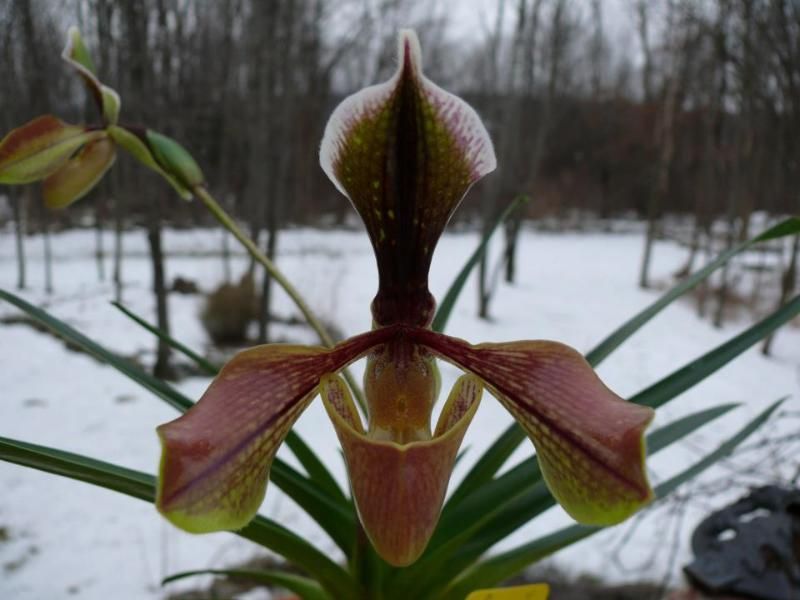SlipperKing
Madd Virologist
Anyone heard anything on these?
6. Zhong-Jian Liu, Olaf Gruss, Li-Jun Chen. Paphiopedilum cornuatum und Paphiopedilum × nitens, eine neue Art und eine neue Naturhybride aus Yunnan, China. Die Orchidee. 2011, 62 (4): 275 ~ 279.
5. Zhong-Jian Liu, Olaf Gruss, Li-Jun Chen. Paphiopedilum stenolomum ZJ LIU, O. GRUSS & LJ CHEN, spec. Nov. Und Paphiopedilum × wuliangshanicum ZJ LIU, O. GRUSS & LJ CHEN, hybr, nov., eine neue Art und eine neue Naturhybride der Gattung Paphiopedilum aus Yunnan, China. Die Orchidee. 2011, 62 (3): 189 ~ 192.
Whatcha think of this gratrixianum/villosum?

This image was posted by my friend Yijia Wang on Facebook
and here is some of the discussion about the above flower
Frank Cervera
(Yesterday )
Paphiopedilum gratrixianum v. cangyuanense. A valid description :http://sinicaorchid.gd168.net/PaperView.Asp?Id=58
What is the difference between this variety and villosum, baxalii, annamense, affine?
Paphiopedilum gratrixianum v cangyuanense. Penjelasan valid: http://sinicaorchid.gd168.net/PaperView.Asp?Id=58
...See More — with Nguyễn Hải Triều, Welton Carvalho, Sol Orien Orchis Nursery and 35 others in Westtown, NY.
Like · · Share
115 people like this.
4 shares
View all 23 comments
Olaf Gruß my knowledge about the complex villosum - gratrixianum - affine - boxallii and the intergrades between is not so good that I could decide. Also there is so great variability in this complex in the single species that I would not like to write the label for your plant. Perhaps Guido will do it?
14 hours ago · Like · 2
Guido Jozef Braem Species are variable ... it is time that we acknowledge that and stop describing each variant as a separate taxon, but I guess this will never happen. Alternatively, we should admit trat subspecific differentiation is simply arbitrary. And that is why I started off the "complexes".
13 hours ago · Like · 5
Canh Chu Xuan We also have some varieties from different location in Vietnam. For local name we called them by the name of the location of that species occurs but for scientific name we call all villosum.
13 hours ago · Edited · Like · 4
Guido Jozef Braem that is an acceptable solution
12 hours ago · Like · 3
TropicalExotique Orchids What if there are two or three varieties occur within the same location? Only, what if...
12 hours ago via mobile · Like · 2
Guido Jozef Braem Call them Guangdong # 1 and Guangdong # 2 (for example)
12 hours ago · Like · 3
6. Zhong-Jian Liu, Olaf Gruss, Li-Jun Chen. Paphiopedilum cornuatum und Paphiopedilum × nitens, eine neue Art und eine neue Naturhybride aus Yunnan, China. Die Orchidee. 2011, 62 (4): 275 ~ 279.
5. Zhong-Jian Liu, Olaf Gruss, Li-Jun Chen. Paphiopedilum stenolomum ZJ LIU, O. GRUSS & LJ CHEN, spec. Nov. Und Paphiopedilum × wuliangshanicum ZJ LIU, O. GRUSS & LJ CHEN, hybr, nov., eine neue Art und eine neue Naturhybride der Gattung Paphiopedilum aus Yunnan, China. Die Orchidee. 2011, 62 (3): 189 ~ 192.
Whatcha think of this gratrixianum/villosum?

This image was posted by my friend Yijia Wang on Facebook
and here is some of the discussion about the above flower
Frank Cervera
(Yesterday )
Paphiopedilum gratrixianum v. cangyuanense. A valid description :http://sinicaorchid.gd168.net/PaperView.Asp?Id=58
What is the difference between this variety and villosum, baxalii, annamense, affine?
Paphiopedilum gratrixianum v cangyuanense. Penjelasan valid: http://sinicaorchid.gd168.net/PaperView.Asp?Id=58
...See More — with Nguyễn Hải Triều, Welton Carvalho, Sol Orien Orchis Nursery and 35 others in Westtown, NY.
Like · · Share
115 people like this.
4 shares
View all 23 comments
Olaf Gruß my knowledge about the complex villosum - gratrixianum - affine - boxallii and the intergrades between is not so good that I could decide. Also there is so great variability in this complex in the single species that I would not like to write the label for your plant. Perhaps Guido will do it?
14 hours ago · Like · 2
Guido Jozef Braem Species are variable ... it is time that we acknowledge that and stop describing each variant as a separate taxon, but I guess this will never happen. Alternatively, we should admit trat subspecific differentiation is simply arbitrary. And that is why I started off the "complexes".
13 hours ago · Like · 5
Canh Chu Xuan We also have some varieties from different location in Vietnam. For local name we called them by the name of the location of that species occurs but for scientific name we call all villosum.
13 hours ago · Edited · Like · 4
Guido Jozef Braem that is an acceptable solution
12 hours ago · Like · 3
TropicalExotique Orchids What if there are two or three varieties occur within the same location? Only, what if...
12 hours ago via mobile · Like · 2
Guido Jozef Braem Call them Guangdong # 1 and Guangdong # 2 (for example)
12 hours ago · Like · 3


































